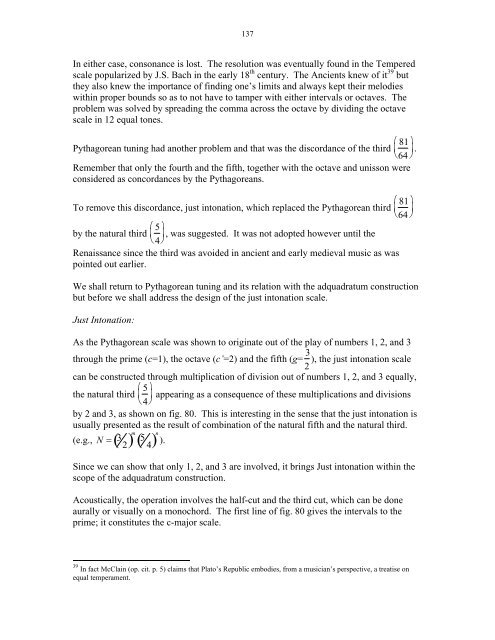Ad Quadratum Construction and Study of the Regular Polyhedra
Ad Quadratum Construction and Study of the Regular Polyhedra
Ad Quadratum Construction and Study of the Regular Polyhedra
You also want an ePaper? Increase the reach of your titles
YUMPU automatically turns print PDFs into web optimized ePapers that Google loves.
137<br />
In ei<strong>the</strong>r case, consonance is lost. The resolution was eventually found in <strong>the</strong> Tempered<br />
scale popularized by J.S. Bach in <strong>the</strong> early 18 th century. The Ancients knew <strong>of</strong> it 39 but<br />
<strong>the</strong>y also knew <strong>the</strong> importance <strong>of</strong> finding one’s limits <strong>and</strong> always kept <strong>the</strong>ir melodies<br />
within proper bounds so as to not have to tamper with ei<strong>the</strong>r intervals or octaves. The<br />
problem was solved by spreading <strong>the</strong> comma across <strong>the</strong> octave by dividing <strong>the</strong> octave<br />
scale in 12 equal tones.<br />
Pythagorean tuning had ano<strong>the</strong>r problem <strong>and</strong> that was <strong>the</strong> discordance <strong>of</strong> <strong>the</strong> third 81 <br />
.<br />
64<br />
<br />
Remember that only <strong>the</strong> fourth <strong>and</strong> <strong>the</strong> fifth, toge<strong>the</strong>r with <strong>the</strong> octave <strong>and</strong> unisson were<br />
considered as concordances by <strong>the</strong> Pythagoreans.<br />
To remove this discordance, just intonation, which replaced <strong>the</strong> Pythagorean third 81 <br />
<br />
64<br />
<br />
by <strong>the</strong> natural third 5 <br />
<br />
4<br />
<br />
, was suggested. It was not adopted however until <strong>the</strong><br />
<br />
Renaissance since <strong>the</strong> third was avoided in ancient <strong>and</strong> early medieval music as was<br />
pointed out earlier.<br />
We shall return to Pythagorean tuning <strong>and</strong> its relation with <strong>the</strong> adquadratum construction<br />
but before we shall address <strong>the</strong> design <strong>of</strong> <strong>the</strong> just intonation scale.<br />
Just Intonation:<br />
As <strong>the</strong> Pythagorean scale was shown to originate out <strong>of</strong> <strong>the</strong> play <strong>of</strong> numbers 1, 2, <strong>and</strong> 3<br />
through <strong>the</strong> prime (c=1), <strong>the</strong> octave (c’=2) <strong>and</strong> <strong>the</strong> fifth (g= 3<br />
), <strong>the</strong> just intonation scale<br />
2<br />
can be constructed through multiplication <strong>of</strong> division out <strong>of</strong> numbers 1, 2, <strong>and</strong> 3 equally,<br />
<strong>the</strong> natural third 5 <br />
<br />
4<br />
<br />
appearing as a consequence <strong>of</strong> <strong>the</strong>se multiplications <strong>and</strong> divisions<br />
<br />
by 2 <strong>and</strong> 3, as shown on fig. 80. This is interesting in <strong>the</strong> sense that <strong>the</strong> just intonation is<br />
usually presented as <strong>the</strong> result <strong>of</strong> combination <strong>of</strong> <strong>the</strong> natural fifth <strong>and</strong> <strong>the</strong> natural third.<br />
(e.g., N 3 2<br />
m<br />
5 4<br />
n<br />
).<br />
Since we can show that only 1, 2, <strong>and</strong> 3 are involved, it brings Just intonation within <strong>the</strong><br />
scope <strong>of</strong> <strong>the</strong> adquadratum construction.<br />
Acoustically, <strong>the</strong> operation involves <strong>the</strong> half-cut <strong>and</strong> <strong>the</strong> third cut, which can be done<br />
aurally or visually on a monochord. The first line <strong>of</strong> fig. 80 gives <strong>the</strong> intervals to <strong>the</strong><br />
prime; it constitutes <strong>the</strong> c-major scale.<br />
39<br />
In fact McClain (op. cit. p. 5) claims that Plato’s Republic embodies, from a musician’s perspective, a treatise on<br />
equal temperament.




